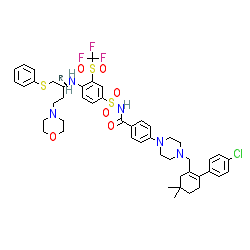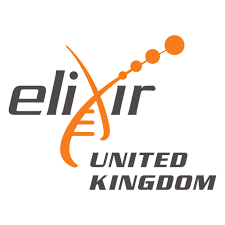|
Synonyms: ABT 263 | ABT-263
Compound class:
Synthetic organic
Comment: Navitoclax is a potent and orally active BH3 mimetic which antagonises the action of Bcl-2 family proteins Bcl-2, Bcl-xL and Bcl-w [6]. This compound is the result of medicinal chemistry effort to increase aqueous solubility of the parent compound ABT-737. Navitoclax has senolytic activity against senescent cells in a range of pathological conditions [2-3,5,7-9].
Ligand Activity Visualisation ChartsThese are box plot that provide a unique visualisation, summarising all the activity data for a ligand taken from ChEMBL and GtoPdb across multiple targets and species. Click on a plot to see the median, interquartile range, low and high data points. A value of zero indicates that no data are available. A separate chart is created for each target, and where possible the algorithm tries to merge ChEMBL and GtoPdb targets by matching them on name and UniProt accession, for each available species. However, please note that inconsistency in naming of targets may lead to data for the same target being reported across multiple charts. ✖ |
|
|||||||||||||||||||||||||||||||||||
| References |
|
1. Amundson SA, Myers TG, Scudiero D, Kitada S, Reed JC, Fornace Jr AJ. (2000)
An informatics approach identifying markers of chemosensitivity in human cancer cell lines. Cancer Res, 60 (21): 6101-10. [PMID:11085534] |
|
2. Budamagunta V, Kumar A, Rani A, Manohar Sindhu S, Yang Y, Zhou D, Foster TC. (2024)
Senolytic treatment alleviates doxorubicin-induced chemobrain. Aging Cell, 23 (2): e14037. [PMID:38225896] |
|
3. Escriche-Navarro B, Garrido E, Sancenón F, García-Fernández A, Martínez-Máñez R. (2024)
A navitoclax-loaded nanodevice targeting matrix metalloproteinase-3 for the selective elimination of senescent cells. Acta Biomater, 176: 405-416. [PMID:38185231] |
|
4. Green DR, Evan GI. (2002)
A matter of life and death. Cancer Cell, 1 (1): 19-30. [PMID:12086884] |
|
5. Maggiorani D, Le O, Lisi V, Landais S, Moquin-Beaudry G, Lavallée VP, Decaluwe H, Beauséjour C. (2024)
Senescence drives immunotherapy resistance by inducing an immunosuppressive tumor microenvironment. Nat Commun, 15 (1): 2435. [PMID:38499573] |
|
6. Park CM, Bruncko M, Adickes J, Bauch J, Ding H, Kunzer A, Marsh KC, Nimmer P, Shoemaker AR, Song X et al.. (2008)
Discovery of an orally bioavailable small molecule inhibitor of prosurvival B-cell lymphoma 2 proteins. J Med Chem, 51 (21): 6902-15. [PMID:18841882] |
|
7. Ro DH, Cho GH, Kim JY, Min SK, Yang HR, Park HJ, Wang SY, Kim YJ, Lee MC, Bae HC et al.. (2024)
Selective targeting of dipeptidyl-peptidase 4 (DPP-4) positive senescent chondrocyte ameliorates osteoarthritis progression. Aging Cell, 23 (7): e14161. [PMID:38556837] |
|
8. Sato S, Ogawa Y, Shimizu E, Asai K, Okazaki T, Rusch R, Hirayama M, Shimmura S, Negishi K, Tsubota K. (2024)
Cellular senescence promotes meibomian gland dysfunction in a chronic graft-versus-host disease mouse model. Ocul Surf, 32: 198-210. [PMID:38499288] |
|
9. Zheng H, Liu M, Shi S, Huang H, Yang X, Luo Z, Song Y, Xu Q, Li T, Xue L et al.. (2024)
MAP4K4 and WT1 mediate SOX6-induced cellular senescence by synergistically activating the ATF2-TGFβ2-Smad2/3 signaling pathway in cervical cancer. Mol Oncol, [Epub ahead of print]. [PMID:38383842] |







